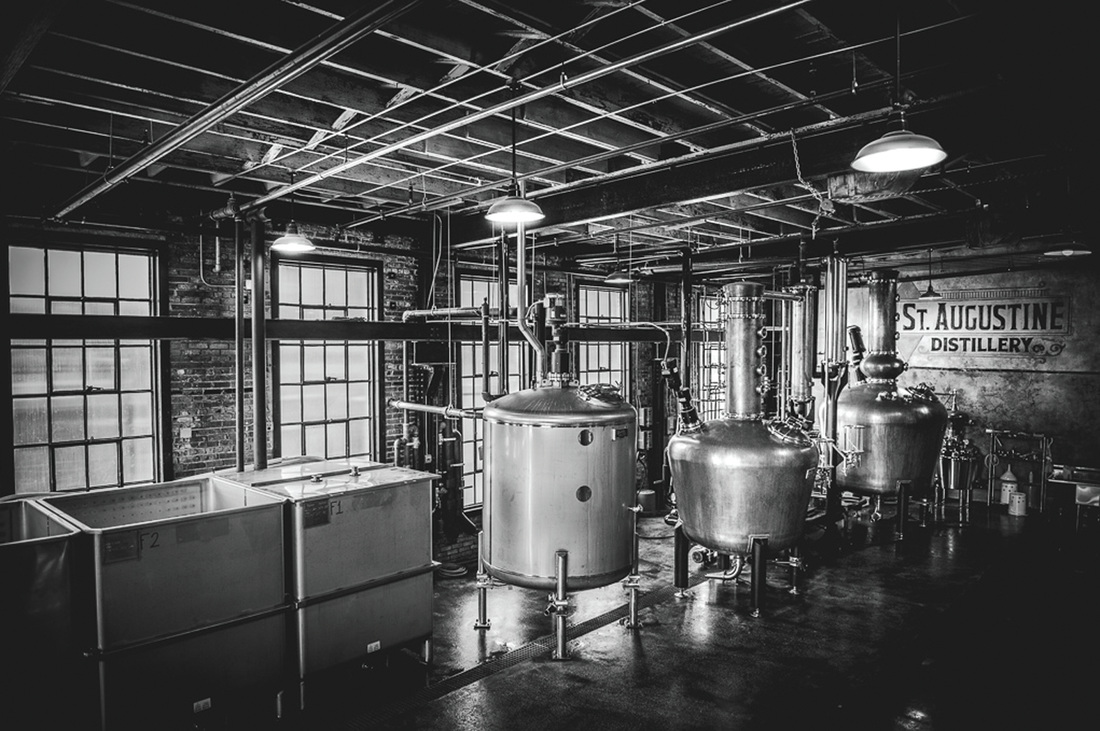|
By Darren Rosenbaum
Every time I’m in St. Augustine, I travel through time. Whether I’m visiting the Castillo, walking by the Bridge of Lions, the Government House or a Flagler hotel, every corner of the ‘Ancient City’ seems alive with history. I didn’t think it could get any better than that until I met Philip McDaniel, co-founder and CEO of the St. Augustine Distillery since it opened for business in 2014. Located about ¼ mile south of the intersection of King and Riberia Streets, the St. Augustine Distillery has become ‘the’ favorite place for visitors near and far, even ranking #1 on TripAdvisor.com! As a business, destination and museum, a visit to the St. Augustine Distillery is certainly memorable. Upon arrival, guests are asked if they’d like to be part of the tour, which begins at the museum. In a nod to history, each guest stamps their own time card as if they were laborers clocking in for a shift early in the 20th century! As you enter, prepare to be surrounded by local history with a contemporary, eco-friendly twist. Lining the walls are pictures of the Distillery circa 1917, as a plant that produced 300 lb. ice blocks from ‘brine water’ for delivery to local eateries and Flagler’s hotels! As you walk the room, it’s hard not to gaze at the period memorabilia filling the glass topped display cases. Explanations of the distilling process abound as well. Whether it’s the importance of ‘head, heart and tail’, how humidity plays a role in ‘seasoning’ the barrel’s oak staves or how sugar, yeast, nutrients and other variables play a critical role in fermenting and distilling fine spirits, learning has never been so enjoyable! Just before the tour heads into the production area, focus your attention on the south wall. That’s where you’ll see numerous sign boards detailing the role the St. Augustine Distillery plays in the local economy. While Philip believes the St. Augustine Distillery will be the Southeast’s premier distiller within 18 months, that kind of expansion doesn’t worry him. ‘As we grow, we will work with our farming partners, vendors, environmental engineers to solve whatever challenges we face.’ That said, he’s justifiably proud of the local crops used in the distillation process. Not only does it create and sustain local jobs and job growth, but by ‘recycling dollars’ through the purchase of locally made products, ‘the revenues and proceeds remain in the local economy’. This promotes an eco-friendly footprint as ‘locally made products require less transportation’ and ‘helps keep our little piece of the world just a bit cleaner and greener’. In fact, almost nothing in the distillation process goes to waste as even the spent grains from the mashing process are available to local farmers as feed for cattle. As we entered the production area, Philip explained how grains, sugar cane and other raw materials are transformed into rum, gin, vodka and whisky. Along with some trial and error, distilling spirits involves mashing, boiling, reading hydrometers, condensing and separating product from ‘co-product’, in other words, chemistry. In fact, as Philip discussed formulas, percentages and proof, I felt like I was back in 11th grade, struggling to keep up in Chemistry class! His interest and knowledge seemed infinite but even he admitted it was complicated and requires the employ of an experienced head distiller. For me though, standing next to the beautiful copper Vendome stills, one a 750 gallon pot still for mashing and the other a 500 gallon spirit still for bourbon, rum and vodka, made my day. Nearly 20 ft. tall, these industrial works of art were custom built for the Distillery and, at full production, allow for bottling up to 120 cases per day! It’s after distillation that certain variables play a role in how a fine bourbon or rum will taste. According to Philip, the type of oak used, the amount of charring and even the size of the barrel account for up to ’60-70% of the taste of a whisky’. Currently, the Distillery has ‘batch’ produced four distinct rums as part of their Discovery Series and is nearly done aging their first batch of whisky, which should be ready summer or fall of 2016. It’s clear that the ‘Ancient City’ has another gem to add to its list of wonders. Not only have Philip McDaniel and the staff at the St. Augustine Distillery transformed a forgotten part of town, they have created a thriving business with a great future. Stop by soon to see history come alive.
0 Comments
Leave a Reply. |
St. Johns MagazineSt. Johns Magazine blog features articles written by & about the people, places and events of St. Johns and the surrounding communities. Archives
July 2022
Categories
All
|
Proudly powered by Weebly

 RSS Feed
RSS Feed
